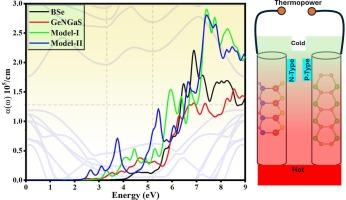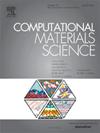用于增强光电和热电应用的BSe/GeNGaS范德华异质结构:第一性原理的观点
IF 3.3
3区 材料科学
Q2 MATERIALS SCIENCE, MULTIDISCIPLINARY
引用次数: 0
摘要
范德华异质结构(vdWHt)是由不同的二维(2D)材料堆叠而成的,为先进的光电和热电应用提供了一个有前途的平台。本研究基于第一性原理密度泛函理论结合半经典玻尔兹曼输运理论,提出了BSe/GeNGaS vdwht模型i和模型ii。这两种vdWHt都是能量稳定和动态稳定的。这两种结构在本征电场作用下表现出ii型带对准,有效抑制了光诱导载流子的复合。值得注意的是,模型1显示出直接带隙,使其特别适合集成到光电器件中。与原始单层相比,vdWHt表现出增强的光学性能,可见光吸收范围扩展到105 cm−1。在700 K时,模型i和模型ii的最大热电性能值(ZT)分别达到1.15和1.05,显示出高温热电应用的强大潜力。这些发现为下一代基于vdwht的光电和热电器件的设计和开发提供了有价值的见解。本文章由计算机程序翻译,如有差异,请以英文原文为准。

The BSe/GeNGaS van der Waals heterostructures for enhanced optoelectronic and thermoelectric applications: A first-principles perspective
Van der Waals heterostructures (vdWHt), established by stacking dissimilar two-dimensional (2D) materials, present a promising platform for advanced optoelectronic and thermoelectric applications. In this study, BSe/GeNGaS vdWHt—referred to as Model-I and Model-II—were proposed based on first-principles density functional theory combined with semiclassical Boltzmann transport theory. Both vdWHt were confirmed to be energetically and dynamically stable. The two configurations exhibited type-II band alignments with intrinsic electric fields, effectively suppressing the recombination of photo-induced charge carriers. Notably, Model-I exhibited a direct band gap, making it particularly more suitable for integration into optoelectronic devices. Compared with their pristine monolayer counterparts, the vdWHt demonstrated enhanced optical performance, with visible-range absorption extending up to 105 cm−1. The maximum thermoelectric figure of merit (ZT) reached 1.15 for Model-I and 1.05 for Model-II at 700 K, indicating strong potential for high-temperature thermoelectric applications. These findings provide valuable insights for the design and development of next-generation vdWHt-based optoelectronic and thermoelectric devices.
求助全文
通过发布文献求助,成功后即可免费获取论文全文。
去求助
来源期刊

Computational Materials Science
工程技术-材料科学:综合
CiteScore
6.50
自引率
6.10%
发文量
665
审稿时长
26 days
期刊介绍:
The goal of Computational Materials Science is to report on results that provide new or unique insights into, or significantly expand our understanding of, the properties of materials or phenomena associated with their design, synthesis, processing, characterization, and utilization. To be relevant to the journal, the results should be applied or applicable to specific material systems that are discussed within the submission.
 求助内容:
求助内容: 应助结果提醒方式:
应助结果提醒方式:


